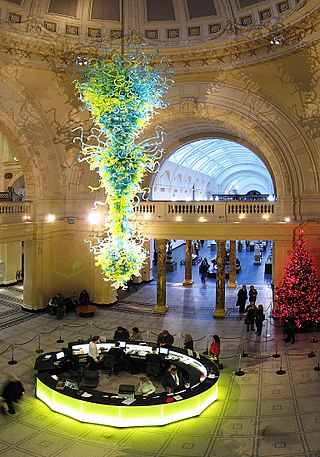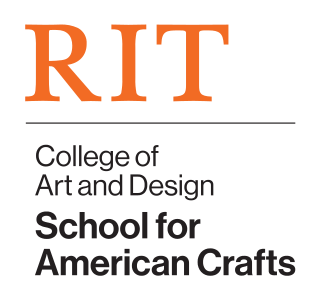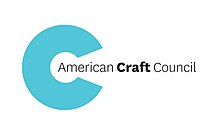Paul Edmund Soldner was an American ceramic artist and educator, noted for his experimentation with the 16th-century Japanese technique called raku, introducing new methods of firing and post firing, which became known as American Raku. He was the founder of the Anderson Ranch Arts Center in 1966.

American craft is craft work produced by independent studio artists working with traditional craft materials and processes. Examples include wood, glass, clay (ceramics), textiles, and metal (metalworking). Studio craft works tend to either serve or allude to a functional or utilitarian purpose, although they are just as often handled and exhibited in ways similar to visual art objects.

The Museum of Arts and Design (MAD), based in Manhattan, New York City, collects, displays, and interprets objects that document contemporary and historic innovation in craft, art, and design. In its exhibitions and educational programs, the museum celebrates the creative process through which materials are crafted into works that enhance contemporary life.

Robert Brady is an American modernist sculptor who works in ceramics and wood. Born in Reno, Nevada, he has made his home in the San Francisco Bay Area for many decades. Brady is a multi-faceted artist who works in ceramics, wood, painting, and illustration, and is best known for his abstract figurative sculptures. Brady came out of the California Clay movement, and the Bay Area Arts scene of the 1950s and 1960s, which includes artists such as Peter Voulkos, Viola Frey, Stephen de Staebler, and Robert Arneson who was his mentor and teacher in college.

Rudolf Harry "Rudi" Staffel was an American ceramic artist and educator.
The Museum of Contemporary Craft (1937-2016) in Portland, Oregon was the oldest continuously-running craft institution on the west coast of the United States until its closure in 2016. The museum's mission was "to enliven and expand the understanding of craft and the museum experience." It was known as one of the few centers in the United States to focus on the relationships between art and craft, programming robust shows exploring a wide variety of artists, materials and techniques.
William Henry Osborn was an American businessman and philanthropist. He was a railroad tycoon who, as head of the Illinois Central Railroad and later the Chicago, St. Louis and New Orleans Railroad, became one of the most prominent railroad leaders in the United States. A friend and patron of the painter Frederic Edwin Church, he was an avid art collector. His two sons went on to become presidents of prominent museums in New York City.

William Church Osborn was the son of a prominent New York City family who served in a variety of civic roles including president of the Metropolitan Museum of Art, president of the Children's Aid Society, and president of the New York Society for the Relief of the Ruptured and Orphaned.
Frances Maude Senska was an art professor and artist specializing in ceramics who taught at Montana State University – Bozeman from 1946 to 1973. She was known as the "grandmother of ceramics in Montana". During her career, she trained a number of now internationally known ceramic artists.

Aileen Osborn Webb (1892–1979) was an American patron of crafts. She was a founder of the organization now known as the American Craft Council, which gives an annual award named for her. She was considered a "principal supporter" of the American Craft movement during the Great Depression. She founded the School for American Craftsmen (SAC), which is now part of Rochester Institute of Technology (RIT).
Paul J. Smith was an arts administrator, curator, and artist based in New York. Smith was professionally involved with the art, craft, and design fields since the early 1950s and was closely associated with the twentieth-century studio craft movement in the United States. He joined the staff of the American Craftsmen's Council in 1957, and in 1963 was appointed Director of the Museum of Contemporary Crafts, a position he held for the next 25 years. In September 1987, he assumed the title of director emeritus and continued to work as an independent curator and consultant for museums, arts organizations, and collectors.

Emil Milan was an American woodworker known for his carved bowls, birds, and other accessories and art in wood. Trained as a sculptor at the Art Students League of New York, he designed and made wooden ware in the New York City metropolitan area, and later in rural Pennsylvania where he lived alone and used his barn as a workshop. Participating in many woodworking, craft, and design exhibits of his day, his works are in the Smithsonian American Art Museum and Renwick Gallery, the Yale Art Gallery, the Center for Art in Wood, the Museum of Art and Design, and many private collections. Once prominent in midcentury modern design, Milan slipped into obscurity after his death. His legacy has been revived by an extensive biographical research project that has led to renewed interest in his life, work, and influence.

Rose Slivka was an American poet and writer for women's magazines in the twentieth century. From 1959 to 1979 she was the editor-in-chief for Craft Horizons. Her 1978 book on the artist Peter Voulkos is considered the first contemporary craft monograph.
Kurt Weiser is an American ceramicist and professor. His work—explorations of the relationship between man and nature through narratives rendered in vivid color—are described as "Eden-like." His work has often taken the form of teapots, vases, and cups, though he has recently begun crafting globes as well. Weiser is currently the Regents Professor at Arizona State University's School of Art.
Adda "Andy" Thyra Elise Louise Husted-Andersen was a Danish-born American Modernist jeweler, silversmith, metalsmith, and educator. She was a co-founder and the president of the New York Society of Craftsmen from 1941 to 1944. She was a master of working with enamel, silver and gold. She was active in New York City and Copenhagen.
Gerry Williams was an American artist. He was a ceramist and a co-founder of Studio Potter magazine.

Craft Horizons is a periodical magazine that documents and exhibits crafts, craft artists, and other facets of the field of American craft. The magazine was founded by Aileen Osborn Webb and published from 1941 to 1979. It included editorials, features, technical information, letters from readers, and photographs of craft artists, their tools, and their works. The magazine both "documented and shaped" the changing history of the American craft movement. It was succeeded by American Craft in 1979.
American Craft is a periodical magazine that documents crafts, craft artists, and both practical and creative aspects of the field of American craft. Originally founded by Aileen Osborn Webb in 1941 as Craft Horizons, the magazine has been published by the nonprofit American Craft Council under the title American Craft since November 1979.
Jan Dunn born in Springvale, Victoria, Australia, was a potter, ceramicist and teacher.

The School for American Crafts was founded by Aileen Osborn Webb and the American Craftsmen's Council (ACC) in the 1940s. It sought to provide training in traditional crafts and "to develop and raise the standards of the hand arts in the United States."










